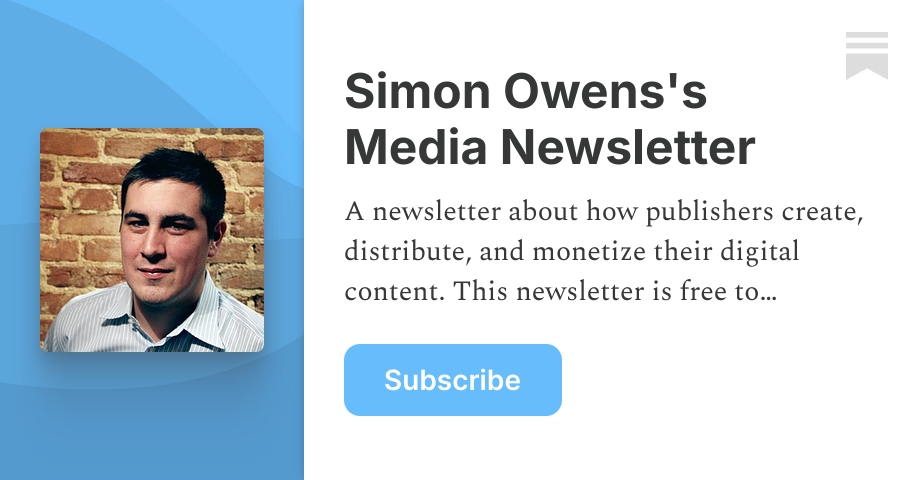Greg Piechota challenges some long-held beliefs about the economics of digital distribution in a call for publishers to invest more in it. As he says, the cost of digital distribution is lower than print, but it’s not zero. Publisher’s reliance on organic - read free - distribution via search and social meant distorted (my words, not Greg’s) publishers’ expectations of what it cost to reach digital audiences. And I would add that it distorted the true value of these rented audiences. The value of audiences who have a direct relationship with a publisher is higher than those rented audiences. But Greg is making a broader point than simply converting unknown, loosely connected audiences to known contacts. He is also saying that publishers need to invest in their products, and they need to invest in distribution. After all, as he points out, Google paid as much as $10bn a year to be the default search engine on Apple’s devices. The bottom line is that free traffic is gone - if it ever existed - and publishers will need to invest in distribution if they want to survive.
I attended the Audiencers Festival in London a few weeks back, and a session on newsletters drove the point home once again on how valuable they are in engaging audiences, which leads to conversion and retention. The Telegraph has found “if a reader subscribes to their premium product after clicking on a newsletter, they’re 50% more likely to still be a subscriber after 12 months”, Maire Bonheim, Head of Newsletters at The Telegraph, said. It’s great to see data that proves the importance of newsletters to retention.
Questions have always swirled around newsletters with a view that younger audiences don’t read email, and this was raised at the Audiencers Festival. The durability of email newsletters has surprised me, and if anything, newsletters have come into their own as standalone products as well as parts of a modern media product portfolio.
As far as a standalone product, newsletters have proven themselves as the minimum viable local news product. Instead of a network of local news sites, we are seeing more networks of local newsletters. Michael MacLeod, Founder of The Edinburgh Guardian, talked about his experience launching the newsletter, which aggregates local news in Edinburgh. And retention was a major theme again. Only 5% who have subscribed have unsubscribed.
They have found a tremendous amount of engagement - not just views but also messages. Moreover, most of the users are local to the publication so not just audiences from elsewhere but actually in the US state that they cover.
This was big news in the UK Wednesday with the largest local news publisher - Reach - cutting 10% of their workforce. Their social-reliant traffic acquisition model has led to major issues with their digital traffic, leading to a 16% decline in their digital revenue. Having worked as a consultant with Reach for almost three years 2016 to 2018, this news is heart-breaking and hit a number of people I know.
The media industry continues to reduce its reliance on advertising, and Footballco, a footie-focused media business, is looking to grow its affiliate revenue this year. The only question that I have about putting their eggs in this basket is the impact that changes in search referrals might have to affiliate sales.
I have taken to saying that I rotate days using one of the new social media platforms. Hey, it is Tuesday, it must be Bluesky Day. I am happy to hear that I am not alone in feeling a little adrift when it comes to social media platforms. I am in four or five Slacks. I am on Bluesky, Threads and Mastodon, although I haven’t logged into the latter anytime recently more because I struggle to. And I’m still on X, Facebook, Instagram and Flickr. Ugh, too much. Too much.
I post this only because it shows how the New York Times is progressing in its work on bundles. They hit 10m subscriptions a year ago, but this is 10m subscribers.
The death of a pioneer Philip Meyer might be called the Father of Data Journalism, but I think he would want to be remembered as the Father of Precision Journalism. He brought rigour and social science to his journalism and championed that application. For me, it was this data-driven interrogation of a story that was and still is revolutionary. This contribution cannot be underestimated.
I am adding this as someone who developed an incredible appreciation for management during my master’s degree. This is one to read and reflect on. Every manager faces fear, but then there is a question of what a manager does with that. This research indicates that some managers are not managing their own emotions. Not only are their employees paying for it, but their businesses are as well.






































































